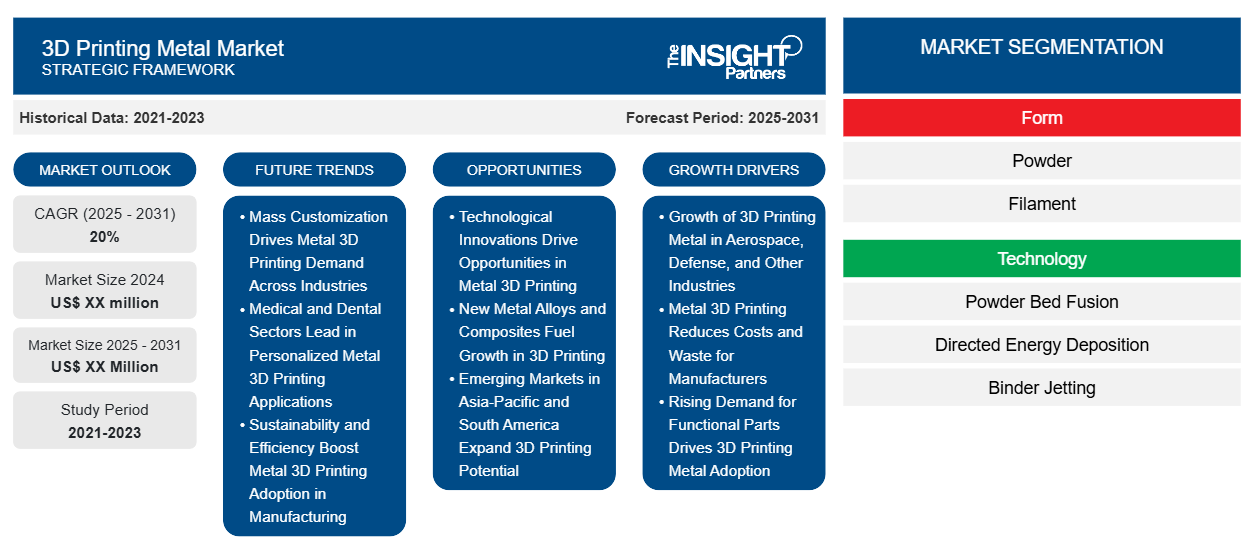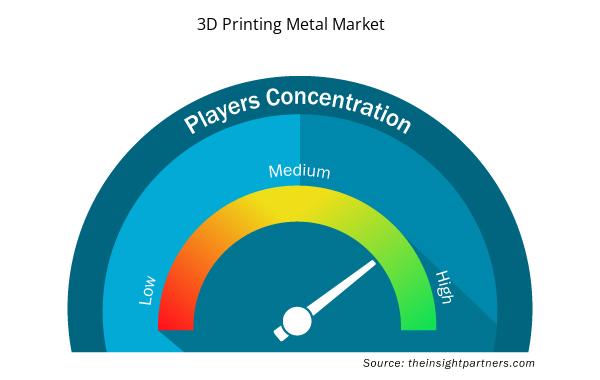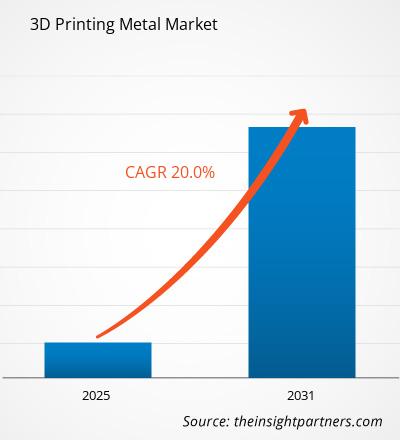Se espera que el mercado de impresión 3D de metal registre una CAGR del 20% entre 2025 y 2031, con un tamaño de mercado que se expandirá de US$ XX millones en 2024 a US$ XX millones en 2031.
El informe del mercado de impresión 3D de metal se segmenta por formato (polvo y filamento). Además, presenta un análisis basado en la tecnología (fusión de lecho de polvo, deposición de energía dirigida, inyección de aglutinante, extrusión de metal, etc.). El informe se segmenta según el tipo de metal (titanio, níquel, acero inoxidable, aluminio, etc.). También se analiza según la industria de uso final (aeroespacial y defensa, automotriz, médica, etc.). El análisis global se desglosa a nivel regional y por países principales. El alcance del informe abarca el tamaño y las previsiones del mercado a nivel global, regional y nacional para todos los segmentos clave del mercado. El informe ofrece el valor en USD para el análisis y los segmentos mencionados.
Propósito del Informe
El informe "Mercado de Impresión 3D de Metales" de The Insight Partners busca describir el panorama actual y el crecimiento futuro, los principales factores impulsores, los desafíos y las oportunidades. Esto proporcionará información a diversos actores del sector, como:
- Proveedores/Fabricantes de Tecnología: Para comprender la dinámica cambiante del mercado y conocer las oportunidades potenciales de crecimiento, lo que les permitirá tomar decisiones estratégicas informadas.
- Inversores: Realizar un análisis exhaustivo de tendencias respecto a la tasa de crecimiento del mercado, las proyecciones financieras del mercado y las oportunidades que existen en toda la cadena de valor.
- Organismos reguladores: Regular las políticas y las actividades policiales en el mercado con el objetivo de minimizar el abuso, preservar la confianza de los inversores y defender la integridad y estabilidad del mercado.
Segmentación del mercado de impresión 3D de metal
Forma
- Polvo
- Filamento
Tecnología
- Fusión de lecho de polvo
- Deposición de energía dirigida
- Inyección de aglutinante
- Extrusión de metal
Industria de uso final
- Aeroespacial y Defensa
- Automotor
- Médico
Tipo de metal
- Titanio
- Níquel
- Acero inoxidable
- Aluminio
Personalice este informe según sus necesidades
Obtendrá personalización en cualquier informe, sin cargo, incluidas partes de este informe o análisis a nivel de país, paquete de datos de Excel, así como también grandes ofertas y descuentos para empresas emergentes y universidades.
Mercado de impresión 3D de metales: Perspectivas estratégicas

- Obtenga las principales tendencias clave del mercado de este informe.Esta muestra GRATUITA incluirá análisis de datos, desde tendencias del mercado hasta estimaciones y pronósticos.
Factores que impulsan el crecimiento del mercado de la impresión 3D de metales
- Crecimiento de la impresión 3D de metal en la industria aeroespacial, de defensa y otras: El mercado de la impresión 3D de metal está experimentando un crecimiento significativo, impulsado por diversos factores en diversas industrias, como la aeroespacial y de defensa, la automotriz, la médica y dental, entre otras. La industria aeroespacial y de defensa son los mayores consumidores de metal para impresión 3D, ya que se utiliza para prototipos, piezas de uso final e incluso reemplazos rápidos. La demanda de materiales de alto rendimiento, como aquellos sometidos a condiciones de uso extremas, como el titanio o el aluminio, impulsa considerablemente el crecimiento de este sector.
- La impresión 3D en metal reduce costos y desperdicios para los fabricantes: Los fabricantes se benefician de la impresión 3D en metal gracias a la reducción de costos de fabricación y plazos de entrega mínimos, a la vez que minimizan los desperdicios en el punto de producción. Esta característica atrae a muchos fabricantes que buscan optimizar sus procesos.
- La creciente demanda de piezas funcionales impulsa la adopción de la impresión 3D en metal: La demanda de piezas funcionales, especialmente en industrias manufactureras como la automotriz y la aeroespacial, se está convirtiendo en el principal motor de crecimiento. Empresas de diversos sectores, como la aeroespacial y la defensa, la automotriz y la médica, han comenzado a utilizar cada vez más la impresión 3D para fabricar piezas que cumplen con criterios de rendimiento específicos.
Tendencias futuras del mercado de impresión 3D de metales
- La personalización masiva impulsa la demanda de impresión 3D en metal en todas las industrias: Existe una tendencia creciente hacia la personalización masiva. Las empresas están aprovechando la impresión 3D en metal para producir productos específicamente diseñados para cada cliente. La demanda de productos más personalizados en muchas industrias, como la médica y la aeroespacial, está en aumento.
- Los sectores médico y dental lideran las aplicaciones de impresión 3D de metal personalizada: Las industrias médica y dental son uno de los principales mercados que utilizan la impresión 3D de metal para implantes y aparatos dentales personalizados. Las soluciones médicas personalizadas están destinadas a aumentar, y es muy probable que esto se convierta en una nueva tendencia.
- La sostenibilidad y la eficiencia impulsan la adopción de la impresión 3D de metal en la fabricación: Otra tendencia en el mercado es la creciente atención a la reducción de los plazos de fabricación y entrega, así como a la reducción de residuos, características inherentes a la impresión 3D de metal. Diversas industrias buscarán prácticas de fabricación más sostenibles, lo que impulsará el crecimiento del mercado en la eficiencia de las tecnologías de impresión 3D de metal. Asimismo, habrá una fuerte demanda de aplicaciones de prototipado, ya que diversas empresas necesitan esta tecnología para producir y desarrollar prototipos metálicos complejos de forma rápida y rentable.
Oportunidades del mercado de la impresión 3D de metal
- Las innovaciones tecnológicas impulsan las oportunidades en la impresión 3D de metal: Se prevé que las innovaciones tecnológicas ofrezcan oportunidades más lucrativas para el mercado de la impresión 3D de metal durante el período de pronóstico. Existen oportunidades para examinar y comercializar tecnologías de impresión 3D de metal nuevas, eficientes y fiables mediante el avance de la investigación y el desarrollo.
- Nuevas aleaciones metálicas y materiales compuestos impulsan el crecimiento de la impresión 3D: El desarrollo de nuevas aleaciones metálicas y materiales compuestos diseñados específicamente para la impresión 3D ofrecerá mayores oportunidades de crecimiento. Se utilizará una novedosa ciencia de materiales con piezas más resistentes, ligeras y duraderas para lograr un excelente rendimiento en piezas impresas para la industria aeroespacial y automotriz. Diversos actores del mercado también están invirtiendo en investigación y desarrollo para ofrecer productos nuevos, innovadores y de alta calidad que satisfagan la demanda de los clientes.
- Los mercados emergentes de Asia-Pacífico y Sudamérica amplían el potencial de la impresión 3D: Además, regiones emergentes como Asia-Pacífico y Sudamérica están adquiriendo una gran importancia en el panorama de la impresión 3D en metal. Estas regiones suelen ofrecer grandes oportunidades para que las empresas se establezcan allí y aprovechen la creciente demanda de soluciones de fabricación de alta gama.
Perspectivas regionales del mercado de impresión 3D de metales
Los analistas de Insight Partners han explicado detalladamente las tendencias y los factores regionales que influyen en el mercado de la impresión 3D en metal durante el período de pronóstico. Esta sección también analiza los segmentos y la geografía del mercado de la impresión 3D en metal en América del Norte, Europa, Asia Pacífico, Oriente Medio y África, y América del Sur y Central.

- Obtenga los datos regionales específicos para el mercado de impresión 3D de metal
Alcance del informe del mercado de impresión 3D de metales
| Atributo del informe | Detalles |
|---|---|
| Tamaño del mercado en 2024 | US$ XX millones |
| Tamaño del mercado en 2031 | US$ XX millones |
| CAGR global (2025-2031) | 20% |
| Datos históricos | 2021-2023 |
| Período de pronóstico | 2025-2031 |
| Segmentos cubiertos | Por formulario
|
| Regiones y países cubiertos | América del norte
|
| Líderes del mercado y perfiles de empresas clave |
|
Densidad de actores del mercado de impresión 3D de metal: comprensión de su impacto en la dinámica empresarial
El mercado de la impresión 3D en metal está en rápido crecimiento, impulsado por la creciente demanda del usuario final debido a factores como la evolución de las preferencias del consumidor, los avances tecnológicos y un mayor conocimiento de los beneficios del producto. A medida que aumenta la demanda, las empresas amplían su oferta, innovan para satisfacer las necesidades del consumidor y aprovechan las tendencias emergentes, lo que impulsa aún más el crecimiento del mercado.
La densidad de actores del mercado se refiere a la distribución de empresas o compañías que operan en un mercado o sector en particular. Indica cuántos competidores (actores del mercado) hay en un mercado determinado en relación con su tamaño o valor total.
Las principales empresas que operan en el mercado de impresión 3D de metales son:
- Stratasys
- CRS Holdings, LLC.
- Materializar
- Sandvik AB
- Höganäs AB
Descargo de responsabilidad : Las empresas enumeradas anteriormente no están clasificadas en ningún orden particular.

- Obtenga una descripción general de los principales actores clave del mercado de impresión 3D de metal
Puntos clave de venta
- Cobertura integral: el informe cubre de manera integral el análisis de productos, servicios, tipos y usuarios finales del mercado de impresión 3D de metal, proporcionando un panorama holístico.
- Análisis de expertos: el informe se compila con base en el conocimiento profundo de expertos y analistas de la industria.
- Información actualizada: El informe asegura relevancia comercial debido a su cobertura de información reciente y tendencias de datos.
- Opciones de personalización: este informe se puede personalizar para satisfacer los requisitos específicos del cliente y adaptarse adecuadamente a las estrategias comerciales.
Por lo tanto, el informe de investigación sobre el mercado de la impresión 3D de metal puede ayudar a descifrar y comprender el panorama de la industria y sus perspectivas de crecimiento. Si bien existen algunas preocupaciones válidas, las ventajas generales de este informe tienden a superar las desventajas.
- Análisis histórico (2 años), año base, pronóstico (7 años) con CAGR
- Análisis PEST y FODA
- Tamaño del mercado Valor/volumen: global, regional, nacional
- Industria y panorama competitivo
- Conjunto de datos de Excel



Report Coverage
Revenue forecast, Company Analysis, Industry landscape, Growth factors, and Trends

Segment Covered
This text is related
to segments covered.

Regional Scope
North America, Europe, Asia Pacific, Middle East & Africa, South & Central America

Country Scope
This text is related
to country scope.
Preguntas frecuentes
Based on geography, Europe held the largest share of the 3D printing metal market due to the well-established automotive and aerospace industry across the region.
Based on end-use industry, the aerospace and defense segment is expected to witness the fastest growth during the forecast period
ATI, Colibrium Additive, CRS Holdings LLC, GKN Powder Metallurgy, Kennametal Inc, Materialise NV, Sandvik, CNPC Powders, Höganäs AB, and INDO-MIM are some of the key players operating in the 3D printing metal market
Rising demand for 3D printing metals from the automotive and aerospace industry are driving the market growth
The 3D Printing Metal Market is estimated to witness a CAGR of 20% from 2023 to 2031
Rising demand for the customized products is expected to be the key market trends
Trends and growth analysis reports related to Chemicals and Materials : READ MORE..
The List of Companies
- Stratasys
- CRS Holdings, LLC.
- Materialise
- Sandvik AB
- Höganäs AB
- EOS
- Desktop Metal, Inc.
- SLM Solutions
- Sculpteo
- Markforged
The Insight Partners performs research in 4 major stages: Data Collection & Secondary Research, Primary Research, Data Analysis and Data Triangulation & Final Review.
- Data Collection and Secondary Research:
As a market research and consulting firm operating from a decade, we have published and advised several client across the globe. First step for any study will start with an assessment of currently available data and insights from existing reports. Further, historical and current market information is collected from Investor Presentations, Annual Reports, SEC Filings, etc., and other information related to company’s performance and market positioning are gathered from Paid Databases (Factiva, Hoovers, and Reuters) and various other publications available in public domain.
Several associations trade associates, technical forums, institutes, societies and organization are accessed to gain technical as well as market related insights through their publications such as research papers, blogs and press releases related to the studies are referred to get cues about the market. Further, white papers, journals, magazines, and other news articles published in last 3 years are scrutinized and analyzed to understand the current market trends.
- Primary Research:
The primarily interview analysis comprise of data obtained from industry participants interview and answers to survey questions gathered by in-house primary team.
For primary research, interviews are conducted with industry experts/CEOs/Marketing Managers/VPs/Subject Matter Experts from both demand and supply side to get a 360-degree view of the market. The primary team conducts several interviews based on the complexity of the markets to understand the various market trends and dynamics which makes research more credible and precise.
A typical research interview fulfils the following functions:
- Provides first-hand information on the market size, market trends, growth trends, competitive landscape, and outlook
- Validates and strengthens in-house secondary research findings
- Develops the analysis team’s expertise and market understanding
Primary research involves email interactions and telephone interviews for each market, category, segment, and sub-segment across geographies. The participants who typically take part in such a process include, but are not limited to:
- Industry participants: VPs, business development managers, market intelligence managers and national sales managers
- Outside experts: Valuation experts, research analysts and key opinion leaders specializing in the electronics and semiconductor industry.
Below is the breakup of our primary respondents by company, designation, and region:

Once we receive the confirmation from primary research sources or primary respondents, we finalize the base year market estimation and forecast the data as per the macroeconomic and microeconomic factors assessed during data collection.
- Data Analysis:
Once data is validated through both secondary as well as primary respondents, we finalize the market estimations by hypothesis formulation and factor analysis at regional and country level.
- Macro-Economic Factor Analysis:
We analyse macroeconomic indicators such the gross domestic product (GDP), increase in the demand for goods and services across industries, technological advancement, regional economic growth, governmental policies, the influence of COVID-19, PEST analysis, and other aspects. This analysis aids in setting benchmarks for various nations/regions and approximating market splits. Additionally, the general trend of the aforementioned components aid in determining the market's development possibilities.
- Country Level Data:
Various factors that are especially aligned to the country are taken into account to determine the market size for a certain area and country, including the presence of vendors, such as headquarters and offices, the country's GDP, demand patterns, and industry growth. To comprehend the market dynamics for the nation, a number of growth variables, inhibitors, application areas, and current market trends are researched. The aforementioned elements aid in determining the country's overall market's growth potential.
- Company Profile:
The “Table of Contents” is formulated by listing and analyzing more than 25 - 30 companies operating in the market ecosystem across geographies. However, we profile only 10 companies as a standard practice in our syndicate reports. These 10 companies comprise leading, emerging, and regional players. Nonetheless, our analysis is not restricted to the 10 listed companies, we also analyze other companies present in the market to develop a holistic view and understand the prevailing trends. The “Company Profiles” section in the report covers key facts, business description, products & services, financial information, SWOT analysis, and key developments. The financial information presented is extracted from the annual reports and official documents of the publicly listed companies. Upon collecting the information for the sections of respective companies, we verify them via various primary sources and then compile the data in respective company profiles. The company level information helps us in deriving the base number as well as in forecasting the market size.
- Developing Base Number:
Aggregation of sales statistics (2020-2022) and macro-economic factor, and other secondary and primary research insights are utilized to arrive at base number and related market shares for 2022. The data gaps are identified in this step and relevant market data is analyzed, collected from paid primary interviews or databases. On finalizing the base year market size, forecasts are developed on the basis of macro-economic, industry and market growth factors and company level analysis.
- Data Triangulation and Final Review:
The market findings and base year market size calculations are validated from supply as well as demand side. Demand side validations are based on macro-economic factor analysis and benchmarks for respective regions and countries. In case of supply side validations, revenues of major companies are estimated (in case not available) based on industry benchmark, approximate number of employees, product portfolio, and primary interviews revenues are gathered. Further revenue from target product/service segment is assessed to avoid overshooting of market statistics. In case of heavy deviations between supply and demand side values, all thes steps are repeated to achieve synchronization.
We follow an iterative model, wherein we share our research findings with Subject Matter Experts (SME’s) and Key Opinion Leaders (KOLs) until consensus view of the market is not formulated – this model negates any drastic deviation in the opinions of experts. Only validated and universally acceptable research findings are quoted in our reports.
We have important check points that we use to validate our research findings – which we call – data triangulation, where we validate the information, we generate from secondary sources with primary interviews and then we re-validate with our internal data bases and Subject matter experts. This comprehensive model enables us to deliver high quality, reliable data in shortest possible time.

 Obtenga una muestra gratuita de este informe
Obtenga una muestra gratuita de este informe